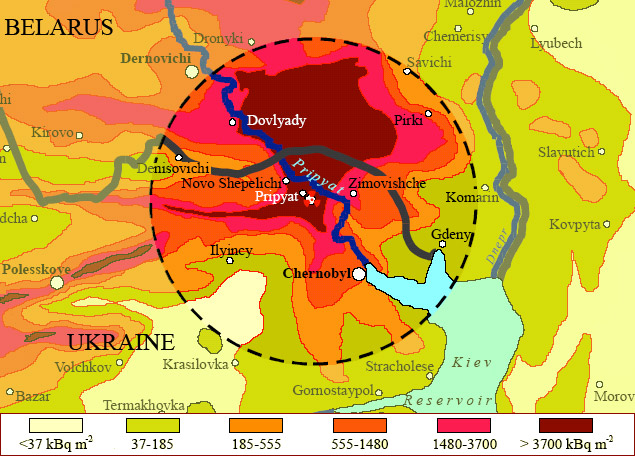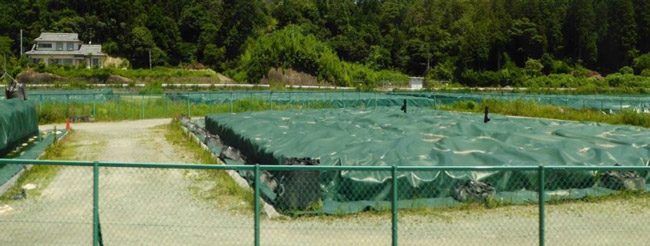Provide shelter, evacuate, clean up and control food
After a major rradioactive release, it is necessary to take emergencu measures. Simple and effective precautions reduce the most dramatic impacrs. At Chernobyl, the first steps taken by the Soviet authorities were late. However, they limited the consequences of the accident.
A first measure is to ptovide shelter during the fitst most critical hours. Sheltering protects against external irradiation from the release, deposits on the ground, inhalation of activity from the plume, and contamination of the skin and clothing. During the Tokaimura accident, despite the absence of significant releases, 300,000 people were kept in their homes until the end of the accident. At Fukushima, the first releases of radioactivity occurred 1 to 3 days after the shutdown of the reactors. The delay was used to provide shelter and evacuate populations.
Temporary evacuation is a heavy and traumatic measure, but it protects against all exposures at the time of the release when the irradiation is at its maximum. At the time of the Three Mile Island accident, when there were no significant releases but a risk of explosion, thousands of people were evacuated as a precautionary measure.

Exclusion zone at Chernobyl
This map of the cesium-137 contamination shows an exclusion zone around the Chernobyl reactor defined by a circle of 30 kilometers radius. The exclusion zone encompasses the town of Chernobyl, 12 km from the power station and 74 hamlets. 400 people, often elderly, returned to Chernobyl. Today hundreds of workers work on the site of the power station that receives many visitors. No one is allowed to live in Prypiat and the first 10 km around the power station. All agricultural production is prohibited, Nature has resumed its rights.
© UIP/EULEP/EURADOS
More dramatic is the permanent displacement of the population, as it was practiced at Chernobyl where an exclusion zone of 30 kilometers around the plant was defined, requiring the relocation and rehousing of 130,000 people. From May 2 to 6, 1986, thousands of people living in this highly contaminated perimeter had to abandon their property were evacuated to more or less temporary shelters. Among the 130,000 evacuees, the 48,000 inhabitants of the town of Prypiat in the immediate vicinity of the reactor.
These transfers certainly protect populations from long-term external irradiation due to ground deposits and inhalation of radioactive dust, but they constitute a major trauma. Material compensations are far from compensating for the trauma and distress associated with the evacuation. The psychological consequences, particularly related to the uprooting of populations, are very important. Thus, three years after the Fukushima accident and the evacuation of 170,000 people, according to the Japanese government figures, more than 1,600 of these evacuees have died from indirect causes related to the disaster, including suicides, while the number of casualties due to the radioactivity proper has been very low owing to these evacuations.
After the Fukushima accident, the evacuation of the contaminated territories was followed by a very large decontamination operation. In inhabited and agricultural areas, the soil surface was scraped to remove cesium deposits. This cleaning allowed the return of evacuated populations to certain towns and villages after 3 or 4 years. But only a part of the polulation, the oldest, has returned, the younger and more active generations having chosen to rebuild their lives elsewhere.

Fukushima : storage of contaminated soils
To remove deposits of cesium-137, the radioactivity of which is long-lived, a thin film of earth was scraped from the surface of the soil. Then contaminated soil was accumulated in bags on storage sites. It will be necessary in the future to bury these contaminated soils, to absorb the gamma not absorbed by the bags.
© TEPCO
To prevent the effect of radioactive iodine on the thyroid after an accident, the distribution of iodine pillsnear the reactor sites is recommended. The administration of stable potassium iodide pills protects against ingestion of radioactive iodine. This administration should occur prior to, or as soon as possible after, contamination and should be repeated if contamination persists. In order to ensure a rapid distribution that these pills are stored permanently near nuclear power stations.
Control of food and water protects against contamination of radioactive products in the food chain. This check must be complete. Thus, in the former Soviet Union, contamination of the food chain did not come from the areas closest to the Chernobyl accident where the authorities had taken effective measures, but from a highly contaminated spot in an agricultural area of neighboring Belarus. Soviet authorities initially hushed up the accident. Kolkhozians farmers unaware of it, sold their uncontrolled products that caused significant exposure.